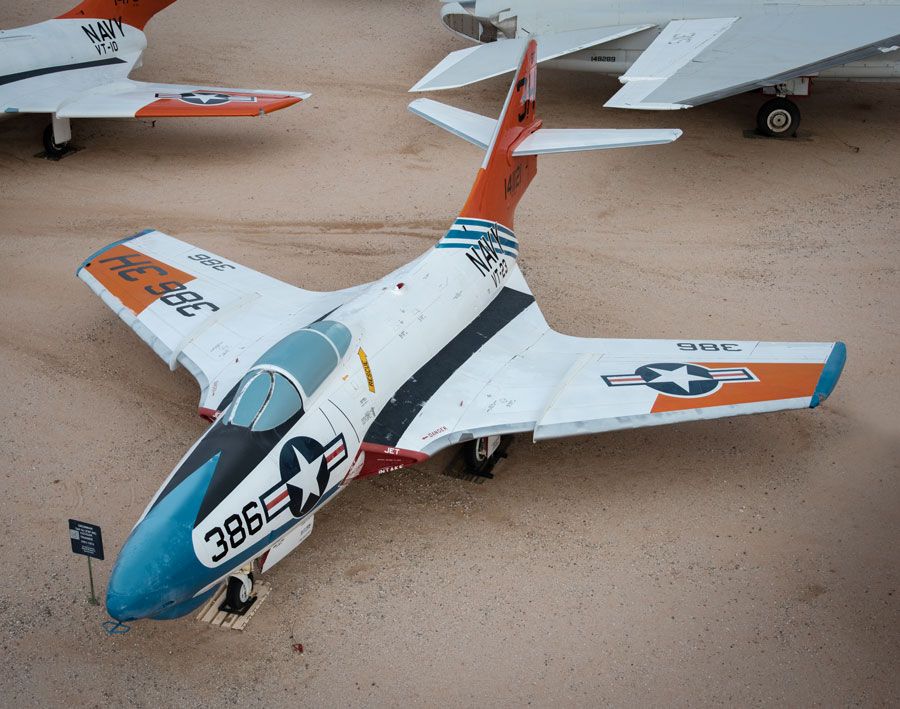Grumman F9F-8B
Grumman F9F-8B (TAF-9J) Cougar

Even before the F9F Panther entered service the Navy and Grumman were examining the possibility of creating a swept-wing version of the aircraft. The appearance of the Soviet MiG-15 over Korea spurred on the process and the prototype made its first flight in September 1951. While the Cougar retained the F9F designation of the earlier Panther it was an almost entirely new design bearing only a superficial resemblance to the Panther. Initially seen as an interim design the Cougar turned out to be very adaptable and several versions and modifications were made over its lifetime. Eventually nearly 2,000 were built and they remained in service until 1974.
The F9F-8 version featured an enlarged wing and more fuel capacity resulting in longer range and better low-speed handling. When tactical nuclear weapons were introduced in the mid-1950s the Navy selected several F9F-8s for conversion to carry the new weapons. These aircraft were equipped with the Low Altitude Bombing System (LABS) and equipment for arming the weapon and were redesignated as F9F-8B. In 1962, when the system of aircraft designations changed this was changed again to AF-9J. Eventually, some of these aircraft found their way into training units and the designation was changed once again to TAF-9J.
| Wingspan | 34 ft 6 in. |
Wingspan |
| Length | 41 ft 9 in. |
Length |
| Height | 12 ft 3 in. |
Height |
| Weight | 24,763 lbs (loaded) |
Weight |
| Max. Speed | 647 MPH |
Maximum Speed |
| Service Ceiling | 42,000 ft |
Service Ceiling |
| Range | 1,200 miles |
Range |
| Engines | Pratt & Whitney J48-P-8A turbojet with 7,250 pounds of thrust |
Engine |
| Crew | 1 |
Crew |
Manufacturer
Grumman
Markings
Training Squadron 23 (VT-23), Naval Air Station Kingsville, Texas, 1969
Designation
F9F-8B
Serial Number
141121
Service History:
Built by Grumman Aircraft, Bethpage, New York as an F9F-8 and delivered to the U.S. Navy on September 21, 1955.
October 1955 To Fighter Squadron 111 (VF-111), Naval Air Station Alameda, California.
February 1956 To Fighter Squadron 153 (VF-153), Naval Air Station Moffett Field, California.
January 1957 Aircraft redesignated as a F9F-8B. Unit redesignated as Attack Squadron 153 (VA-153.)
May 1957 To Attack Squadron 156 (VA-156), Naval Air Station Moffett Field, California.
July 1957 To Naval Advanced Aviation Training Center, Naval Air Station Chase Field, Texas.
April 1958 To Corpus Christi, Texas for overhaul.
November 1958 To Naval Advanced Aviation Training Center, Naval Auxiliary Air Station Kingsville, Texas.
February 1962 To Naval Air Reserve, Naval Air Station Los Alamitos, California.
July 1962 To Litchfield Park, Arizona for storage.
November 1962 Designation changed to AF-9J.
June 1966 To Training Squadron 23 (VT-23), Naval Auxiliary Air Station Kingsville, Texas.
May 1970 To Davis-Monthan AFB, Arizona for storage.
August 1972 Loaned to Pima Air & Space Museum by National Museum of Naval Aviation.
